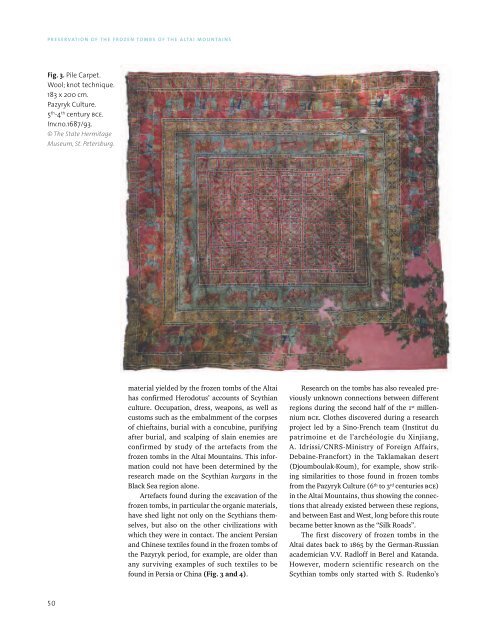Scythian Culture - Preservation of The Frozen Tombs of The Altai Mountains (UNESCO)
Create successful ePaper yourself
Turn your PDF publications into a flip-book with our unique Google optimized e-Paper software.
PRESERVATION OF THE FROZEN TOMBS OF THE ALTAI MOUNTAINS<br />
Fig. 3. Pile Carpet.<br />
Wool; knot technique.<br />
183 x 200 cm.<br />
Pazyryk <strong>Culture</strong>.<br />
5 th -4 th century bce.<br />
Inv.no.1687/93.<br />
© <strong>The</strong> State Hermitage<br />
Museum, St. Petersburg.<br />
material yielded by the frozen tombs <strong>of</strong> the <strong>Altai</strong><br />
has confirmed Herodotus’ accounts <strong>of</strong> <strong>Scythian</strong><br />
culture. Occupation, dress, weapons, as well as<br />
customs such as the embalmment <strong>of</strong> the corpses<br />
<strong>of</strong> chieftains, burial with a concubine, purifying<br />
after burial, and scalping <strong>of</strong> slain enemies are<br />
confirmed by study <strong>of</strong> the artefacts from the<br />
frozen tombs in the <strong>Altai</strong> <strong>Mountains</strong>. This information<br />
could not have been determined by the<br />
research made on the <strong>Scythian</strong> kurgans in the<br />
Black Sea region alone.<br />
Artefacts found during the excavation <strong>of</strong> the<br />
frozen tombs, in particular the organic materials,<br />
have shed light not only on the <strong>Scythian</strong>s themselves,<br />
but also on the other civilizations with<br />
which they were in contact. <strong>The</strong> ancient Persian<br />
and Chinese textiles found in the frozen tombs <strong>of</strong><br />
the Pazyryk period, for example, are older than<br />
any surviving examples <strong>of</strong> such textiles to be<br />
found in Persia or China (Fig. 3 and 4).<br />
Research on the tombs has also revealed previously<br />
unknown connections between different<br />
regions during the second half <strong>of</strong> the 1 st millennium<br />
bce. Clothes discovered during a research<br />
project led by a Sino-French team (Institut du<br />
patrimoine et de l’archéologie du Xinjiang,<br />
A. Idrissi/CNRS-Ministry <strong>of</strong> Foreign Affairs,<br />
Debaine-Francfort) in the Taklamakan desert<br />
(Djoumboulak-Koum), for example, show striking<br />
similarities to those found in frozen tombs<br />
from the Pazyryk <strong>Culture</strong> (6 th to 3 rd centuries bce)<br />
in the <strong>Altai</strong> <strong>Mountains</strong>, thus showing the connections<br />
that already existed between these regions,<br />
and between East and West, long before this route<br />
became better known as the “Silk Roads”.<br />
<strong>The</strong> first discovery <strong>of</strong> frozen tombs in the<br />
<strong>Altai</strong> dates back to 1865 by the German-Russian<br />
academician V.V. Radl<strong>of</strong>f in Berel and Katanda.<br />
However, modern scientific research on the<br />
<strong>Scythian</strong> tombs only started with S. Rudenko’s<br />
50
















